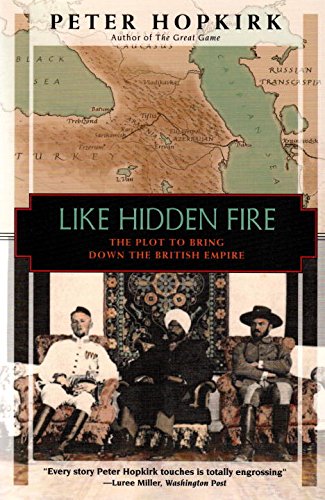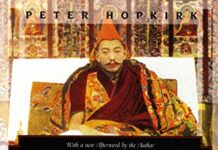
Ebook Info
- Published: 1997
- Number of pages: 448 pages
- Format: PDF
- File Size: 45.12 MB
- Authors: Peter Hopkirk
Description
A GRIPPING STORY OF IMPERIAL AMBITION, SWASHBUCKLING ADVENTURE, AND THE KAISER’S OWN JIHAD. An acclaimed historian tells, for the first time, the full story of the conspiracy between the Germans and the Turks to unleash a Muslim holy war against the British in India and the Russians in the Caucasus. Drawing on recently opened intelligence files and rare personal accounts, Peter Hopkirkskillfully reconstructs the Kaiser’s bold plan and describes the exploits of the secret agents on both sides-disguised variously as archaeologists, traders, and circus performers-as they sought to foment or foil the uprising and determine the outcome of World War I.
User’s Reviews
Editorial Reviews: Review “Every story Peter Hopkirk touches is totally engrossing”—Luree Miller, Washington Post”Exotic settings, uncommon bravery…alliances, intrigue, betrayal: these are the components of Hopkirk’s history…and they are stirring tales indeed.”—The New York Times”Well-written, thoroughly researched.”—Byron Farwell, Washington Times”History that reads like a thriller….With consummate skill, Peter Hopkirk hews a strong narrative line through the tangle of events [and] illuminates the passions and the prizes implicated in today’s turbulent events in the Middle East and Central Asia.”—Luree Miller, Washington Post”Splendid.”—The Atlantic Monthly From the Back Cover Under the banner of a Holy War, masterminded in Berlin and unleashed from Constantinople, the Germans and the Turks set out in 1914 to foment violent revolutionary uprisings against the British in India and the Russians in Central Asia. It was a new and more sinister version of the old Great Game, with world domination as its ultimate aim. As the storm clouds of the First World War loomed, German hawks dreamed of driving the British out of India and creating a vast new Teutonic empire in the East, using their Turkish ally as a springboard. At the same time, Turkey’s leaders aimed to free the Muslim peoples of Central Asia from the Tsarist yoke – and rule them themselves as part of a great new Ottoman empire. The shadowy – and often bloody – struggle that followed was fought out between the intelligence services of King, Kaiser, Sultan, and Tsar. It was to spill over into Persia, Afghanistan, the Caucasus, and Central Asia, and to be felt as far afield as the United States and China. Here, told in epic detail and for the first time, is the extraordinary story of the Turco-German jihad of the First World War, recounted through the adventures and misadventures of the secret agents and others who took part in it. Pieced together from the secret intelligence reports of the day and the long-forgotten memoirs of the participants, Peter Hopkirk’s latest narrative is an enthralling sequel to the acclaimed The Great Game, and his three earlier works set in Central Asia. It is also highly topical in view of recent events in this volatile region where the Great Game has never really ceased. The rise of Islamic fundamentalism and fears of a resurgent Russia and a reunified Germany add greatly to thesignificance of this epic tale. About the Author PETER HOPKIRK, a former reporter for the Times of London, has written several books about adventures in Central Asia, including The Great Game, Setting the East Ablaze, and Trespassers on the Roof of the World, all available from Kodansha Globe. Read more
Reviews from Amazon users which were colected at the time this book was published on the website:
⭐If you are a Hopkirk addict like me, you will breeze through another one of his exciting narratives of Central Asian History and love every minute of it. Fire up the kettle, throw on your fez and curl up in your favourite reading chair as Hopkirk takes you on a true-life tale of derring do against German and Communist Agents in central Asia in World War I.Russia is the ally and the German is the new encroacher on British Empire and the Imperial Indian Raj. Hopkirk of course picks his cast with a loving hand and we have the usual sort of British imperial heroes, speaking the local language, gaining favour from locals with their fair and firm hand, and doling out the intrigue in dollops.But… Hopkirk give us detial of the German Spies in this area as well. Some like Niedermeyer, the German Lawrence and his associate Hentig on their overland journey to Kabul to try to convince the Emir to throw in his lot with the Turkish and Germans and attack British India. The details of his adventures in the Persian deserts and his sojourn in Kabul make great, fast reading. The heebie-jeebies that his action caused the British and their reaction to it are also adventure writ large.Hopkirk describes the German/ Turkish attempt to bring down the British Empire with a holy war orchestrated by themselves. It also shows what brittle fibre holy war is made from. In the end the respective ethnic groups in the muslim world acted in their own self interests — the Persians had no love for a Turkish Empire, the Emir of Afghanistan kept checking which way the wind blew before deciding to remain loyal to Britain. And the Arabs decided that an Englishman (TE Lawrence) held the Key to independence, not their fellow muslims in Constantinople.Once the mess of the Arab Revolt gutted Turkish Power the British find themselves out of the frying pan and into the fire and intervene in the Caucasus’ to try to keep Russia in the war.The British effort here and the emmiment Victorian personalities are well described and the perfidious Red Reaction and myth-making also exploded by Hopkirk.In final analysis Hopkirk writes books alive with adventure. I think that Hopkirk had a major problem in delimiting the book. That is a hard thing to do in a work of this kind. Some things such as the British under seige at Al Kut and its eventual fall are directly related to the tales of our heroes on the ground the political outcome later described. Some other details might have made a shorter book (ie, the Zimmerman Telegram recounting) but they are still interesting and indirectly related to the tale Hopkirk is telling.If you have the ability to honestly judge it then there are a few flaws that should be noted, but they do not at all detract from the flow of the read or the historical smorgasbord laid out before you.In final analysis this book encorporates the widest canvas that Hopkirk has used to date, the World War. That necessitates more detail on distant, but related elements. These may not be as well organised as they could be, but, because Hopkirk writes them, are always highly interesting.A good tea-time book. Something that one looks forward to….
⭐I was captivated by this book. Parts of it could be an action film.My education on World War I omitted portrayal of “the Eastern Front” as anything other than the other front from the Western Front and a place where the Germans fought the Russians and died in very large numbers until the Russians had a revolution.I was happy to learn about a part of the shaping of the Middle East. The writing is as good as that in Hopkirk’s other books, all of which are terrific.The Baku part of the story helped me to understand a bit more about the history of the Caucasus which was also skipped in my schooling, but which has come to affect world events.The saddest part is the drama about whether the British or the German agents can accomplish their goal of bribing the ruler of Afganistan to enter the War. As in The Great Game, nothing has changed and the US is repeating this sad drama a century later.The geopolitical aspects of this part of history continue. The Germans and the Brits looked at tribal leaders as pawns, rather than the leaders of people with aspirations. Many of the genetic and tribal descendants of these pawns are the folks we are dealing with today.This is a book well worth reading and it is nearly as easy to read as a thriller.
⭐In his introduction Hopkirk compares this book to his The Great Game. He says just as that book told the real-life background of Rudyard Kipling’s Kim, this book expands on the real-life background of Buchan’s Greenmantle. Hopkirk claims there is much real-life in Greenmantle and that Buchan was involved in British Intelligence in the time-period.I am anticipating a rewarding journey and will likely re-read Greenmantle with my new-found insights. I know The Great Game helped give me a better feel for Kim.All that said, it should be noted that The Great Game and Like Hidden Fire are books of much greater scope and depth than insights into a couple of popular novels from over a hundred years ago. Hopkirk’s books (these two and his others) are primarily history books that cover the large scale conflicts in central Asia that started hundreds of years ago and continue even up to today. If you are interested in a better understanding of what central Asia is all about these books are the books for you.P.S. Greenmantle outsold Thirty Nine Steps before Hitchcock made his movie.
⭐Hopkirk does a wonderful job in this work of illuminating some of the less well known chapters of the first world war. As usual, his writing is very good and he does a pretty good job of holding the reader’s interest. However, it is on this last point that this work is a half step below Hopkirk’s other works on Central Asia.The nature of this book is such that the history of a world war must be told to put into context the events that Hopkirk describes. As a result, Hopkirk is not able to do what works so very well for him in his other writings. In the others, he is able to focus on one or two charecters at a time and tell their story in a very engaging way. Here, he must combine characters and events and a bit of the good story telling power of Hopkirk’s other works are lost.But, by all means, do pick up the book and read it.
⭐You can count on Peter Hopkirk to deliver fascinating accounts of the lands that served as the arena for The Great Game, and this is no exception. In this well-done volume, Hopkirk tells the tales of intrigue launched at the outset of WWI, mostly aimed at the destruction of the British Empire. While the world was focused on the carnage in Europe, a lesser-known war was raging in Central Asia, where the players were the dying Ottoman Empire, the newly emergent Bolsheviks plus Persian and Caucasian forces and, of course, the British. Hopkirk records these events with a journalists eye toward telling a compelling story. So much of today’s world was influenced by the events Hopkirk describes. This is a valuable book which rounds out our knowledge of a most turbulent time.
⭐This book was published in Europe & UK under the correct title On Secret Service East of Constantinople.
⭐suitable for great game for great game enthusiastsit contains a very useful bibliography should be read in conjunction with the author’s other books
⭐Good read (as are all of Peter Hopkirk’s books), but it is the same book as “On Secret Service East of Constantinople”.
⭐It is very readable history. I will try and get the other two volumes. Not much else to say really.
⭐A must read!
Keywords
Free Download Like Hidden Fire: The Plot to Bring Down the British Empire in PDF format
Like Hidden Fire: The Plot to Bring Down the British Empire PDF Free Download
Download Like Hidden Fire: The Plot to Bring Down the British Empire 1997 PDF Free
Like Hidden Fire: The Plot to Bring Down the British Empire 1997 PDF Free Download
Download Like Hidden Fire: The Plot to Bring Down the British Empire PDF
Free Download Ebook Like Hidden Fire: The Plot to Bring Down the British Empire



